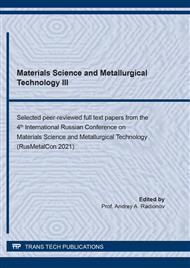[1]
S.L. Burakov, A.I. Veinik, N.P. Dubinin, Chill Casting, Mashinostroenie, Moscow, (1980).
Google Scholar
[2]
K.N. Gavarieva, L.A. Simonova, D.L. Pankratov, R.V. Gavariev, Development of expert systems for modeling of technological process of pressure casting on the basis of artificial intelligence, IOP Conf. Series: Materials Science and Engineering. 240 (2017) 012019.
DOI: 10.1088/1757-899x/240/1/012019
Google Scholar
[3]
S. Yan, J. Xie, Z. Liu, W. Wang, A. Wang, J. Li, Influence of different al contents on microstructure, tensile and wear properties of Zn-based alloy, Journal of Materials Science and Technology. 26(7) (2010) 648-652.
DOI: 10.1016/s1005-0302(10)60100-4
Google Scholar
[4]
A. Pola, L. Montesano, M. Gelfi, G.M. La Vecchia, Comparison of the sliding wear of a novel Zn alloy with that of two commercial Zn alloys against bearing steel and leaded brass, Wear. 368-369 (2016) 445-452.
DOI: 10.1016/j.wear.2016.10.017
Google Scholar
[5]
S.S. Owoeye, D.O. Folorunso, B. Oji, S.G. Borisade, Zinc-aluminum (ZA-27)-based metal matrix composites: a review article of synthesis, reinforcement, microstructural, mechanical, and corrosion characteristics, International Journal of Advanced Manufacturing Technology. 100(1-4) (2019) 373-380.
DOI: 10.1007/s00170-018-2760-9
Google Scholar
[6]
F. G. Karikh, G. F. Muhametzjanova, L.N. Shafigullin, Automation of metal and alloy melting processes using spectral analysis data on the composition of exit gase, IOP Conf. Series: Materials Science and Engineering. 570 (2019) 012039.
DOI: 10.1088/1757-899x/570/1/012039
Google Scholar
[7]
K.N. Gavarieva, L.A. Simonova, D.L. Pankratov, V.G. Shibakov, R.V. Gavariev, Application of multi-agent system for control of parameters of precision stamping process of bevel gears, IOP Conference Series: Materials Science and Engineering. 412 (2018) 012020.
DOI: 10.1088/1757-899x/412/1/012020
Google Scholar
[8]
R.V. Gavariev, I.A. Savin, I.O. Leushin, To the question of casting alloys of non-ferrous metals in the metal mold, Materials Science Forum. 946 (2019) 631-635.
DOI: 10.4028/www.scientific.net/msf.946.631
Google Scholar
[9]
D.L. Pankratov, R.V. Gavariev, Improving the quality of castings made of non-ferrous metal alloys when casting in metal molds, IOP Conf. Series: Materials Science and Engineering. 570 (2019) 012072.
DOI: 10.1088/1757-899x/570/1/012072
Google Scholar
[10]
R.V. Gavariev, I.A. Savin, E.N. Soldatkina, Choice of protective coating of metal molds for casting non-ferrous alloys, Solid State Phenomena. 299 (2020) 867-871.
DOI: 10.4028/www.scientific.net/ssp.299.867
Google Scholar
[11]
N.N. Safronov, L.B. Mingaleeva, I.A. Savin, Optimization of charge material composition in shs process with ferrosilide fabrication from gaseous wastes of metallurgical production, Chernye Metally. 2 (2018) 53-59.
Google Scholar
[12]
A.V. Shaparev, I.A. Savin, Influence of the state of the contact surfaces on the formation of the joint of steel and brass during cold cladding, Solid State Phenomena. 284 (2018) 319-325.
DOI: 10.4028/www.scientific.net/ssp.284.319
Google Scholar
[13]
I.A. Savin, M. Akhmedeev, Connection of the steel pipes having a polymeric covering on internal and external surfaces, Solid State Phenomena. 299 (2020) 766-771.
DOI: 10.4028/www.scientific.net/ssp.299.766
Google Scholar
[14]
I.P. Balabanov, V.N. Gilman, T.S. Timofeeva, A.I. Faskhutdinov, Modeling of the cutting edge rounding influence on the tool life in processing a gear wheel by the Power Skiving method, International Journal of Engineering and Technology (UAE). 7(4) (2018) 71-73.
DOI: 10.14419/ijet.v7i4.7.20386
Google Scholar
[15]
V.N. Gilman, I.P. Balabanov, A.I. Faskhutdinov, Improving the efficiency of shaving through the use of wear-resistant coatings. 570 (2019) 012024.
DOI: 10.1088/1757-899x/570/1/012024
Google Scholar
[16]
A.V. Shaparev, I.A. Savin, Calculation of joint plastic deformation to form metal compound in cold condition, Solid State Phenomena. 265 (2017) 313-318.
DOI: 10.4028/www.scientific.net/ssp.265.313
Google Scholar
[17]
P. Turek, G. Budzik, J. Sęp, Ł. Kochmański, D. Żelechowski, An analysis of the casting polymer mold wear manufactured using polyjet method based on the measurement of the surface topography, Polymers. 12(12) (2020) 3029.
DOI: 10.3390/polym12123029
Google Scholar
[18]
T. Savaşkan, A.P. Hekimoǧlu, Relationships between mechanical and tribological properties of Zn-15Al-based ternary and quaternary alloys, International Journal of Materials Research. 107(7) (2016) 646-652.
DOI: 10.3139/146.111390
Google Scholar
[19]
R.V. Gavariev, K.N. Gavarieva, On the issue of heat balance of molds for injection molding of non-ferrous metal alloys, IOP Conference Series: Materials Science and Engineering. 969(1) (2020) 012069.
DOI: 10.1088/1757-899x/969/1/012069
Google Scholar
[20]
R.V. Gavariev, K.N. Gavarieva, E.N. Soldatkina, Features of design of chill molds for casting of non-ferrous metal, IOP Conference Series: Materials Science and Engineering. 969(1) (2020) 012068.
DOI: 10.1088/1757-899x/969/1/012068
Google Scholar
[21]
D.L. Pankratov, R.V. Gavariev, To the question of automation of the injection molding process, IOP Conference Series: Materials Science and Engineering. 915(1) (2020) 012043.
DOI: 10.1088/1757-899x/915/1/012043
Google Scholar
[22]
A.V. Shaparev, I.A. Savin, S.N. Ptichkin, Application of the polymeric material RIMAMID for production of machine parts, IOP Conf. Series: Materials Science and Engineering. 969 (2020) 012021.
DOI: 10.1088/1757-899x/969/1/012021
Google Scholar
[23]
A.V. Shaparev, I.A. Savin, Calculation of the amount of the reduction required for the formation of compound layers during cold rolling of bimetals, Materials Science Forum. 870 (2016) 328-333.
DOI: 10.4028/www.scientific.net/msf.870.328
Google Scholar
[24]
A.V. Shaparev, Investigation of the effect of oxygen content in the auxiliary process gas on the quality and speed of laser cutting of steel sheets, Solid State Phenomena. 299 (2020) 457-461.
DOI: 10.4028/www.scientific.net/ssp.299.457
Google Scholar


